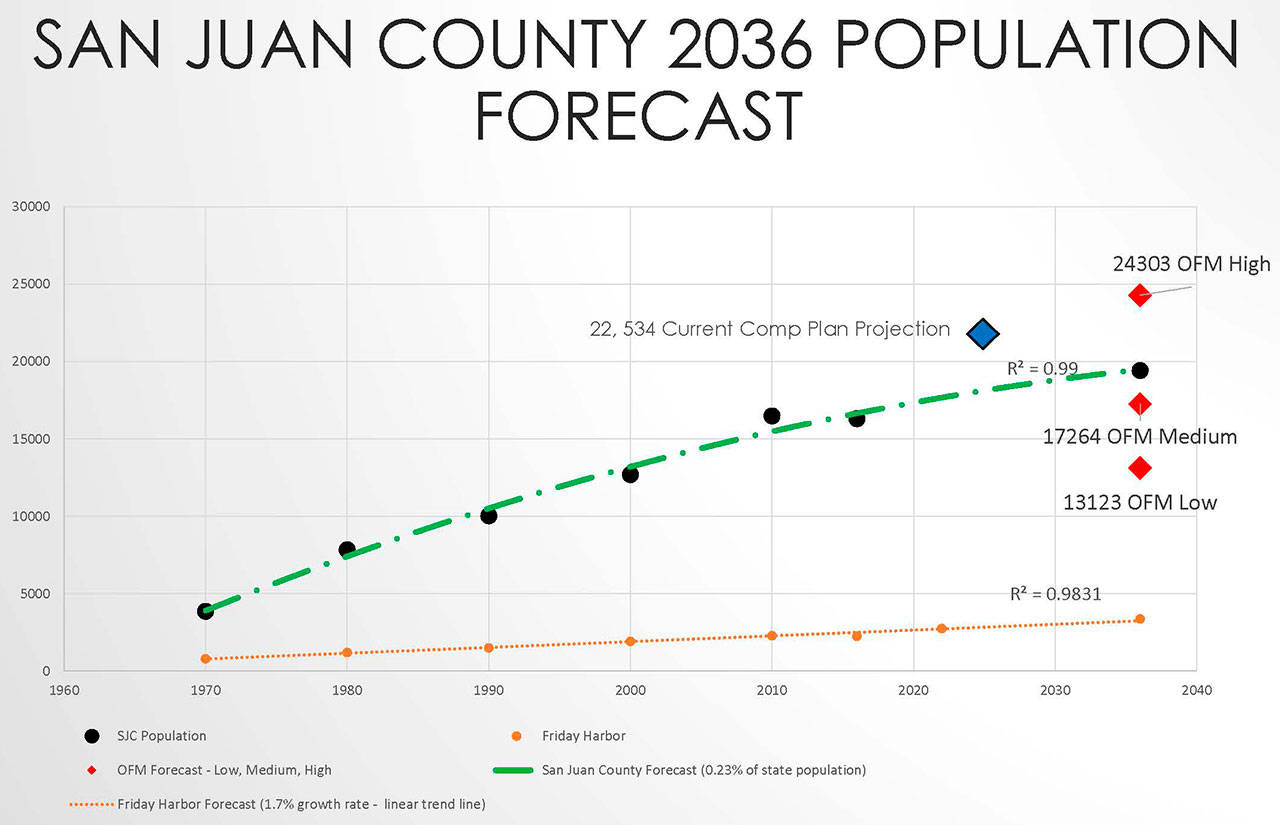San Juan County’s population is rising, but not as fast as the last prediction.
“The point is figuring out that we’re not so small that we’re squished or so big that we’re over-planning,” said Erika Shook, director of San Juan County Community Development at the April 17 county council meeting.
County officials estimate 19,423 people will live on the islands by 2036.
The last prediction in 2005 saw 22,543 county residents in 2025 or a roughly 2 percent annual growth rate. The county’s latest estimation is a little less than 1 percent a year, which is close to the actual population growth of the last 16 years. The prediction includes about 3,000 more residents than on the islands today.
This is outlined in the population projection report, created by San Juan County Community Development Department officials, and will be presented to the county planning commission for recommendations. Council will vote on whether to approve the projection in the next few months.
According to the report, from 1990 to 2000, the population grew by about 4,000. Officials assumed the climb would continue, but by 2010 only about 1,600 new residents had been added — less than half of the previous decade’s growth.
“We started planning [for] facilities, stormwater and roads, and looking at it, we have all this stuff we maybe didn’t really need,” said Councilman Jamie Stephens at the meeting.
He hypothesized that fewer people moved to the islands between 2010 and now because of the high cost of housing.
“When our property values hit a certain point, things slow down,” said Stephens. “We can say there’s been a recession or two in there, but really when the brakes went on, our property values hit a relatively high level.”
People moving to the islands is what increases the population, not increased birth over deaths, stated the report. The growth rate has fluctuated so greatly over the years that it’s too inconsistent to use in estimating future growth.
Instead, community development employees used the percentage of the county’s state population to form the most statically valid estimation possible. An average .23 percent of Washingtonians lived on the islands over the past 36 years, according to the report. Colin Maycock of community development said using average annual growth rates to project the population created a “less valid number.”
“When doing a projection, what we’re doing is using the past to predict the future,” said Shook. “It’s the best we can do without a crystal ball where we don’t know where the migration is going to end up being.”
The population projection is part of the county’s comprehensive plan update, slated to be finished by June 2018. About every decade, the state mandates that municipalities look 20 years into the future to plan for growth, instead of allowing residents to sprawl outside centralized populations.
The state’s Growth Management Act requires people to be concentrated in already populated areas, like towns and Urban Growth Areas. UGAs are unincorporated, but hold similarly sized populations as towns and include Eastsound on Orcas Island and Lopez Village on Lopez Island.
Population projections will be used in future decisions, like developing additional UGAs, as well as determining how many properties are allowed per acre, what activities are allowed on land, the number of roads needed, and where they should be built.
State law requires projections to be consistent with 2036 estimates from the Washington Office of Financial Management, which range from low, medium and high population projections. The county’s estimation falls between the OFM’s medium and high projections for 2036.
According to community development’s report, by then, the Town of Friday Harbor will have 902 new residents and 442 new residential units. Eastsound is projected to have 487 new residents and 239 residential units. Lopez Village is expected to have 33 new residents and 16 new residential units. The average county household includes two people.
Eastsound’s population is growing faster than historically, stated the report.
Currently, Eastsound accounts for about 20 percent of the Orcas population, but increasing the percentage over time proved to be more statistically accurate, said Maycock. By 2040, he estimated Eastsound would hold about 26 percent of the Orcas population.
While the population projection only includes full-time residents, seasonal residents and visitors must be counted as well, reminded Councilman Rick Hughes.
According to San Juan County Planning Manager Linda Kuller, a visitor study — spearheaded by the national parks service — will help determine the population during the peak season. It will be used to review impacts to areas like county infrastructure, facilities, environment, and transportation.
To stay up to date on the plan, visit www.sanjuanco.com/1079/Comprehensive-Plan-Update and sign up for notices at www.sanjuanco.com/list.aspx. Email comments to compplancomments@sanjuanco.com.
For a brief overview of the comprehensive plan, read this article
San Juan County vs. Washington
These population statistics were compiled by the San Juan County Community Development.
• 54 average median age in the county / 37 in the state
• 58% over age 50 in the county / 34% in the state
• 47% have a bachelor’s degree in the county / 33% in the state



